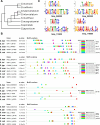Single-cell transcriptomics of the human parasite Schistosoma mansoni first intra-molluscan stage reveals tentative tegumental and stem-cell regulators
- PMID: 38472267
- PMCID: PMC10933418
- DOI: 10.1038/s41598-024-55790-3
Single-cell transcriptomics of the human parasite Schistosoma mansoni first intra-molluscan stage reveals tentative tegumental and stem-cell regulators
Abstract
Schistosomiasis is a major Neglected Tropical Disease, caused by the infection with blood flukes in the genus Schistosoma. To complete the life cycle, the parasite undergoes asexual and sexual reproduction within an intermediate snail host and a definitive mammalian host, respectively. The intra-molluscan phase provides a critical amplification step that ensures a successful transmission. However, the cellular and molecular mechanisms underlying the development of the intra-molluscan stages remain poorly understood. Here, single cell suspensions from S. mansoni mother sporocysts were produced and sequenced using the droplet-based 10X Genomics Chromium platform. Six cell clusters comprising two tegument, muscle, neuron, parenchyma and stem/germinal cell clusters were identified and validated by in situ hybridisation. Gene Ontology term analysis predicted key biological processes for each of the clusters, including three stem/germinal sub-clusters. Furthermore, putative transcription factors predicted for stem/germinal and tegument clusters may play key roles during parasite development and interaction with the intermediate host.
© 2024. The Author(s).
Conflict of interest statement
Carmen Diaz Soria is currently employed at bit.bio, a cell coding company. All the experiments and analyses performed in this study occurred before Carmen Diaz Soria started to work at bit.bio. All other authors have no competing interest to declare.
Figures





Similar articles
-
Single-cell atlas of the first intra-mammalian developmental stage of the human parasite Schistosoma mansoni.Nat Commun. 2020 Dec 18;11(1):6411. doi: 10.1038/s41467-020-20092-5. Nat Commun. 2020. PMID: 33339816 Free PMC article.
-
Epigenetic modulation, stress and plasticity in susceptibility of the snail host, Biomphalaria glabrata, to Schistosoma mansoni infection.Int J Parasitol. 2016 Jun;46(7):389-94. doi: 10.1016/j.ijpara.2016.03.003. Epub 2016 Apr 4. Int J Parasitol. 2016. PMID: 27056272 Review.
-
Analysis of rhodopsin G protein-coupled receptor orthologs reveals semiochemical peptides for parasite (Schistosoma mansoni) and host (Biomphalaria glabrata) interplay.Sci Rep. 2022 May 17;12(1):8243. doi: 10.1038/s41598-022-11996-x. Sci Rep. 2022. PMID: 35581232 Free PMC article.
-
The stage- and sex-specific transcriptome of the human parasite Schistosoma mansoni.Sci Data. 2023 Nov 7;10(1):775. doi: 10.1038/s41597-023-02674-2. Sci Data. 2023. PMID: 37935722 Free PMC article.
-
Schistosoma genomics: new perspectives on schistosome biology and host-parasite interaction.Annu Rev Genomics Hum Genet. 2009;10:211-40. doi: 10.1146/annurev-genom-082908-150036. Annu Rev Genomics Hum Genet. 2009. PMID: 19630560 Review.
Cited by
-
A single-cell atlas of the miracidium larva of Schistosoma mansoni reveals cell types, developmental pathways, and tissue architecture.Elife. 2024 Aug 27;13:RP95628. doi: 10.7554/eLife.95628. Elife. 2024. PMID: 39190022 Free PMC article.
-
Therapeutic Potential of Natural Products in the Treatment of Schistosomiasis.Molecules. 2023 Sep 26;28(19):6807. doi: 10.3390/molecules28196807. Molecules. 2023. PMID: 37836650 Free PMC article. Review.
-
Subtelomeric plasticity contributes to gene family expansion in the human parasitic flatworm Schistosoma mansoni.BMC Genomics. 2024 Feb 27;25(1):217. doi: 10.1186/s12864-024-10032-8. BMC Genomics. 2024. PMID: 38413905 Free PMC article.
-
Comparative analysis of Microtus fortis and murine hosts reveals a correlation between BRD4 and hepatic inflammation during Schistosoma japonicum infection.Parasit Vectors. 2025 Jul 4;18(1):259. doi: 10.1186/s13071-025-06821-z. Parasit Vectors. 2025. PMID: 40616163 Free PMC article.
References
-
- Lo, N. C. et al. Review of 2022 WHO guidelines on the control and elimination of schistosomiasis. Lancet Infect. Dis.22, e327–e335. 10.1016/S1473-3099(22)00221-3 (2022). - PubMed
-
- Rinaldi, G., Attenborough, T., Rawlinson, K. A. & Berriman, M. Schistosomes go single cell. Nat. Rev. Microbiol.20, 705. 10.1038/s41579-022-00810-0 (2022). - PubMed
MeSH terms
Grants and funding
LinkOut - more resources
Full Text Sources
Research Materials

